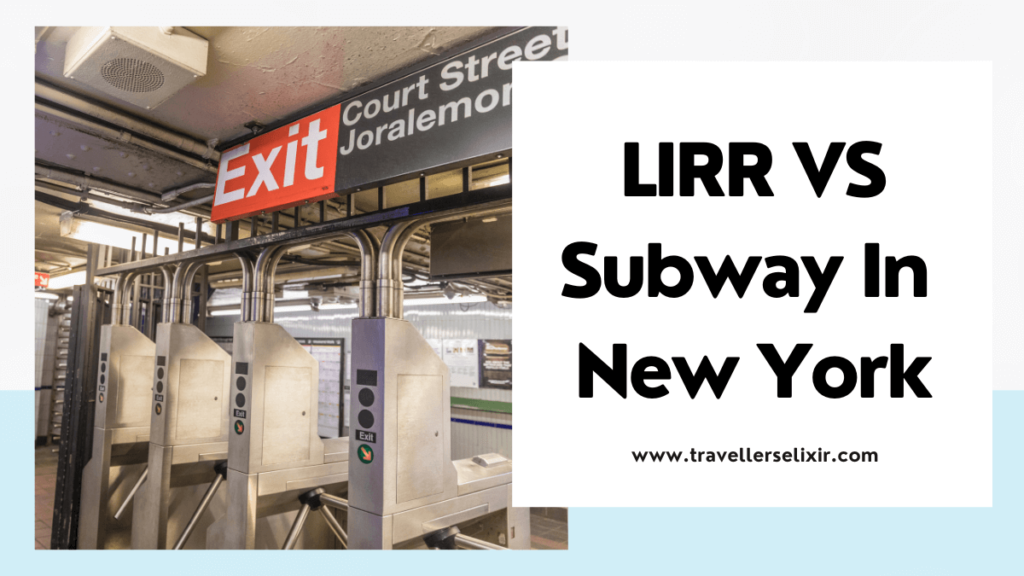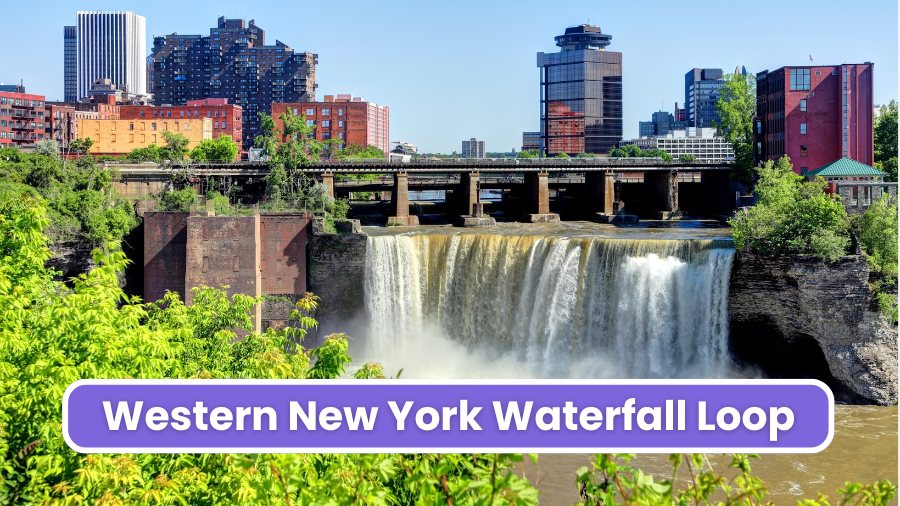The Long Island Rail Road (LIRR) and the subway are two of the best ways to get around New York.
But what’s the difference between them? Should you use the LIRR or the subway?
This handy guide compares the two and includes the key differences between them, which is cheaper and which is faster to help you decide which to use.
What is the Difference Between LIRR and Subway?
The LIRR is a commuter train system that travels overland and extends from Manhattan across the entirety of Long Island. The subway, however, only operates within New York City and is mostly underground.
The LIRR operates a zone fare system which means that the fare varies depending on how far you travel whereas the subway charges just a flat rate for every ride.
Although they are both operated by the same company (MTA), you can’t use any unlimited passes for one system on the other.
Here’s the key differences between the LIRR and the subway in New York:
- The LIRR is more expensive than the subway. You generally pay at least triple the price to ride the LIRR over the subway.
- The subway has 493 stations whereas the LIRR has just 124 stations.
- The subway just serves New York City whereas the LIRR serves New York City and the entire length of Long Island.
- The subway has 36 lines whereas the LIRR only has 11 lines meaning the LIRR is more limited in terms of where you can go.
- The LIRR is much faster than the subway. For most destinations, you can get there in half the time (see examples below).
- LIRR trains are also more frequent and more comfortable than the subway.
- The subway is largely underground however the LIRR is completely overground.
- The subway has significantly more stations in Manhattan, Brooklyn and the Bronx. The LIRR only has one station in Manhattan which is very limiting.
Both the LIRR and the subway run 24/7. This means that they run 24 hours a day, 7 days a week, 365 days a year – they never stop running (not even on Christmas).
This makes them both reliable forms of transportation in New York.
The first thing to know is that the LIRR stretches all the way from Manhattan to the eastern tip of Long Island. That’s over 120 miles!
It’s a commuter train that is designed to serve the city of New York and Long Island.
In comparison, the subway only serves the city of New York. It stretches through all of New York’s boroughs including Manhattan, Brooklyn, Queens and the Bronx but doesn’t stretch into Long Island at all.
Here’s a map showing where the subway and the LIRR operate:
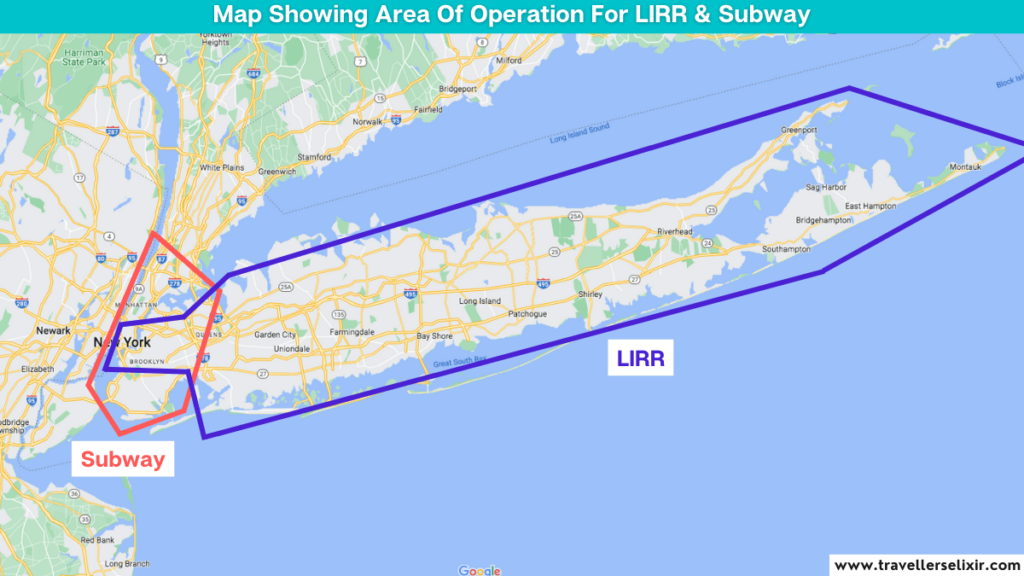
The subway better serves some areas of New York City including Manhattan, Brooklyn and the Bronx. The LIRR better serves other areas of the city like Queens and the entirety of Long Island.
As an example, the LIRR only has one station in the whole of Manhattan (Penn Station). In contrast, the subway has 151 stations in Manhattan alone.
In total, the LIRR has 124 stations and covers over 700 miles of track. It has 11 lines which start in Manhattan then cover the entire length of Long Island all the way to Montauk on the eastern tip.
In contrast, the subway has 493 stations and covers 693 miles of track. It has 36 different lines which are all restricted to New York City itself.
If you’re a tourist trying to get around New York then you’ll likely find the subway better serves you as there are more stations.
Which Is Cheaper: Subway vs LIRR?
The subway is much cheaper than the LIRR. The subway charges a flat rate for all rides whereas the LIRR charges a varied rate depending on when and where you’re going.
In general, the LIRR tends to cost at least triple the price of the subway.
For most riders, the fare to ride the subway is $2.75 however there are reduced fares for people aged 65 or older, people with disabilities and low-income earners.
The $2.75 is a set fare. It doesn’t matter how long you ride the subway for, the fare is $2.75 regardless.
The LIRR is more expensive than the subway in general and their fares vary depending on the time of day that you travel (peak vs off-peak) and the distance traveled.
Here’s some examples of the fares on the LIRR and how they compare to the subway:
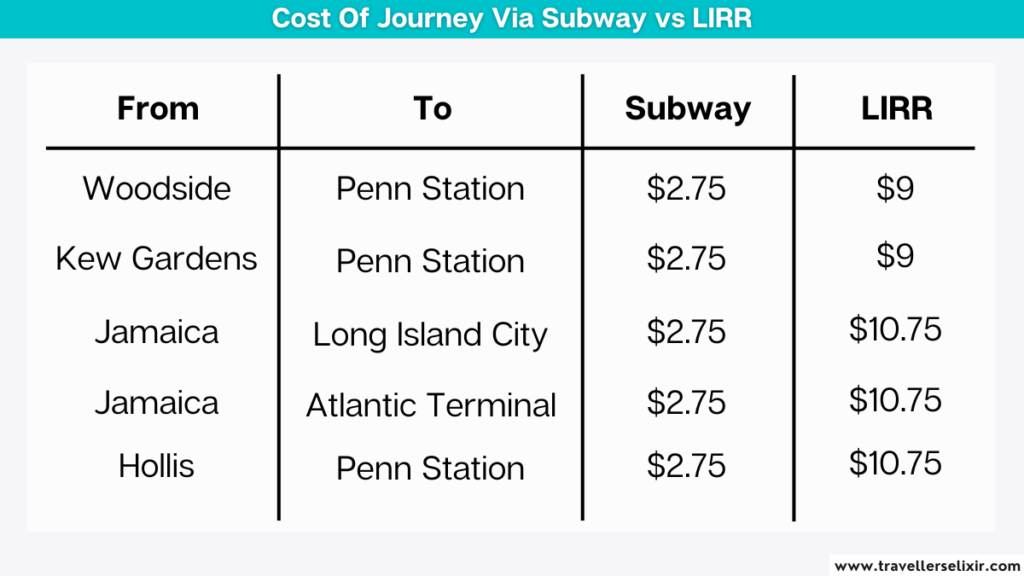
One other benefit of using the LIRR to get to Manhattan over the subway is that you’ll get a really great view of the city.
As the LIRR is completely overground, you can enjoy the magnificent views from the train. As the subway is largely underground, you won’t get any good views.
Is LIRR Faster Than Subway?
Yes, the LIRR is much faster than the subway. For example, it would take 37 minutes to get from Jamaica, Queens to Penn Station, Manhattan on the subway but just 22 minutes on the LIRR.
Here’s a few more examples:
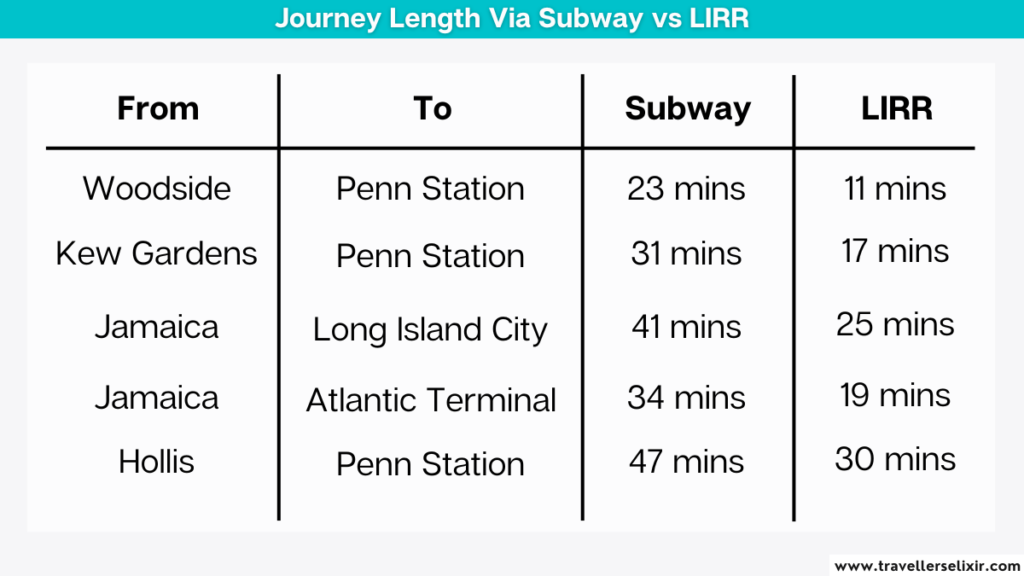
As you can see, in every single example, the LIRR is always faster than the subway. The trains themselves are quicker.
You’ll also find that the trains are more frequent on the LIRR and the carriages are also much more comfortable than the subway.
Is LIRR a Train or Subway?
The LIRR is a commuter train that travels overland whereas the subway is a rapid transit system that is mostly underground however there are some overground routes.
Can I Use MetroCard On LIRR?
No, you cannot use a MetroCard on the LIRR. The LIRR requires its own ticket. You can use your MetroCard on most MTA buses and the subway.
The MetroCard can’t be used on express or private buses though.
For the LIRR, you can pre-book your ticket on the TrainTime app or you can buy a ticket at a ticket machine from the station.
If you purchase at a ticket machine, you can pay with either cash or credit/debit card.
You can use your MetroCard on the subway. You can also use a contactless credit or debit card or your smartphone to pay for your fare.
Simply tap your card or phone on the reader on the turnstile and you can proceed.
Should I Take the LIRR or Subway to JFK?
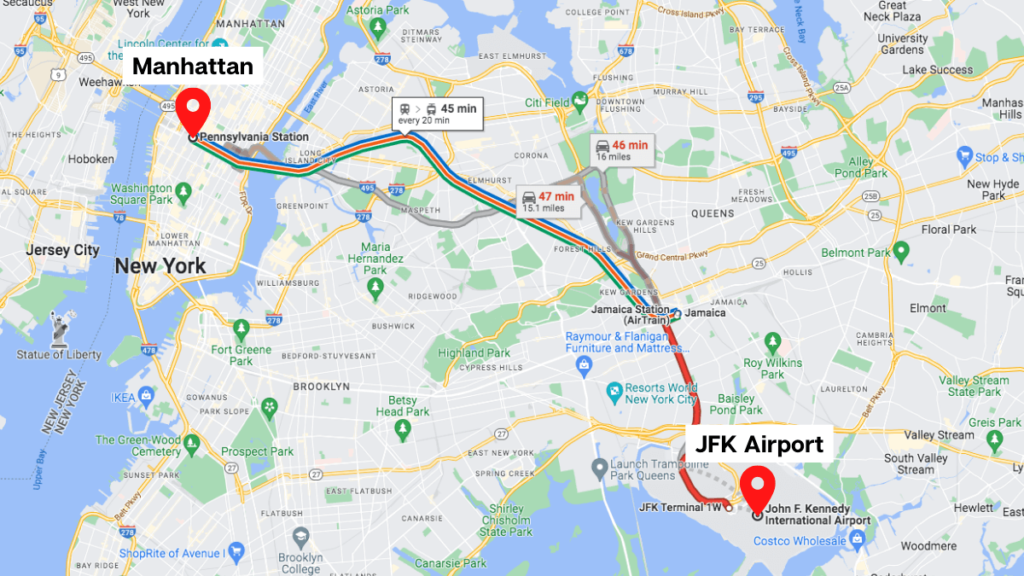
You can get to JFK Airport using both the LIRR and the subway. I personally think the LIRR is better for JFK as the trains have luggage racks and they are much quicker.
The main advantage of using the LIRR over the subway to get to JFK is that it’s quicker. You can get to JFK in just 45 minutes using the LIRR but it would take you an hour using the subway.
Please note that neither the LIRR or the subway takes you directly to JFK. You need to change in Jamaica and take the AirTrain to the airport.
Here’s an overview of the route using Penn Station, Manhattan as a starting point:
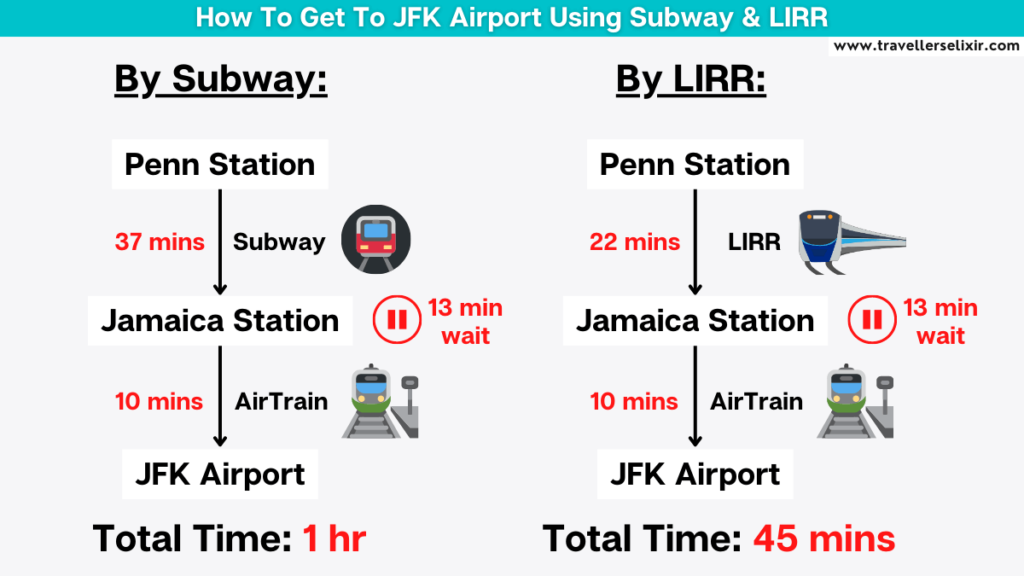
Another advantage of using the LIRR when going to JFK Airport is that they have large overhead luggage racks which makes traveling with suitcases super easy.
Nobody wants to be that person on the subway with a huge suitcase that takes up loads of room and trips people up.
If you’re traveling during rush hour on either the LIRR or the subway then be prepared to stand. Both get very busy and it’s extremely difficult to find a seat.
In general, the LIRR is less busy than the subway as the trains are more frequent (it varies though).
When arriving at Jamaica, you’ll find that the LIRR platform is right next to the AirTrain platform which makes transferring super easy as you do need to take the AirTrain for the last little bit to reach JFK.
As the subway is underground, it will require a bit more navigation to locate the AirTrain platform compared with the LIRR which is overground.
There is really good signage directing you from the subway to the AirTrain though so you shouldn’t have too much trouble.
Cost
When it comes to cost, it will be cheaper to travel to JFK by subway.
If you take the subway it will cost $2.75. You then have to pay $8 to take the AirTrain so in total the cost is $10.75.
If you take the LIRR it will cost $10.75 during peak hours (it’s a few dollars cheaper during off-peak hours). You then have to pay $8 for the AirTrain so in total the cost is $18.75.
As I mentioned, the LIRR will save you 15 minutes of journey time so it’s up to you if you think this is worth the extra money or not.
💡Helpful Tip: If you’re a tourist, figure out which airport is closest to Times Square using my guide. It includes loads of helpful tips!
LIRR vs Subway For Commuters
If you’re a commuter then you might be trying to figure out whether the LIRR or subway would be better suited to your needs.
The first thing to consider is that if you work in Manhattan then the LIRR only serves one station in the whole of Manhattan which is Penn Station.
The subway has 151 stations in Manhattan so it will likely be able to get you much closer to your place of work.
It’s a similar story with Brooklyn and the Bronx. The LIRR only has a few stations in each of these boroughs but the subway serves the entire area really well.
If you’re happy that the LIRR can get you to and from your place of work then the next thing to consider is timings.
The LIRR will get you to your destination much faster than the subway.
Take a look at the following examples:
- Jamaica to Penn Station: 22 mins on the LIRR, 37 mins on the subway.
- Woodside to Penn Station: 11 mins on the LIRR, 23 mins on the subway.
The final thing to consider is the cost. The LIRR is more expensive than the subway. The cost you pay varies depending on the distance traveled.
Here’s a few examples of the difference in cost:
- Jamaica to Penn Station: $10.75 on the LIRR, $2.75 on the subway.
- Woodside to Penn Station: $9 on the LIRR, $2.75 on the subway.
Please note that the LIRR fares here are quoted during peak travel times. You will save a few dollars if you travel during off-peak hours.
You can check your exact fare using the LIRR’s fare checker tool.
As you can see, the LIRR will save you time but it will cost more.
It’s completely down to you on what you value more.
If you can easily afford to pay the extra money and ride the LIRR then I personally think this is a better option as you’ll get more time in your day to do things you enjoy and spend time with your family.
If money is tight then it might be better to ride the subway as the extra money can really add up over time.
And that’s it!
Thanks for reading this post which compares the LIRR vs the subway.
Whether you’re a tourist or a lifelong New Yorker, it can be useful to know your options when it comes to transport.

